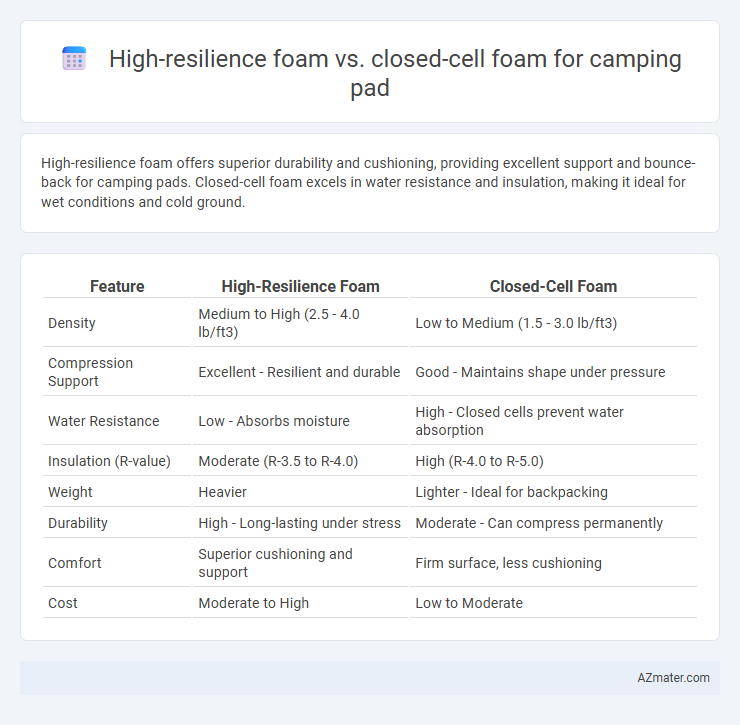High-resilience foam offers superior durability and cushioning, providing excellent support and bounce-back for camping pads. Closed-cell foam excels in water resistance and insulation, making it ideal for wet conditions and cold ground.
Table of Comparison
| Feature | High-Resilience Foam | Closed-Cell Foam |
|---|---|---|
| Density | Medium to High (2.5 - 4.0 lb/ft3) | Low to Medium (1.5 - 3.0 lb/ft3) |
| Compression Support | Excellent - Resilient and durable | Good - Maintains shape under pressure |
| Water Resistance | Low - Absorbs moisture | High - Closed cells prevent water absorption |
| Insulation (R-value) | Moderate (R-3.5 to R-4.0) | High (R-4.0 to R-5.0) |
| Weight | Heavier | Lighter - Ideal for backpacking |
| Durability | High - Long-lasting under stress | Moderate - Can compress permanently |
| Comfort | Superior cushioning and support | Firm surface, less cushioning |
| Cost | Moderate to High | Low to Moderate |
Introduction to Camping Pad Materials
High-resilience foam offers superior cushioning and durability, making it ideal for campers seeking long-lasting comfort and support. Closed-cell foam provides excellent insulation and water resistance, ensuring a dry and warm sleeping surface in damp environments. Choosing between high-resilience and closed-cell foam depends on balancing comfort needs with environmental conditions during camping trips.
What is High-Resilience Foam?
High-resilience foam is a durable, high-density material characterized by its superior elasticity and ability to quickly return to its original shape, making it ideal for camping pads requiring long-lasting comfort and support. This foam's open-cell structure allows for excellent breathability and cushioning, which reduces pressure points during outdoor use. Compared to closed-cell foam, high-resilience foam offers enhanced comfort but may absorb moisture, requiring consideration in wet conditions.
What is Closed-Cell Foam?
Closed-cell foam is a dense, waterproof material consisting of tiny, air-filled cells that resist water absorption and provide superior insulation, making it ideal for camping pads in wet or rugged conditions. This type of foam offers excellent durability, buoyancy, and support, enhancing comfort and protection against cold ground temperatures. High-resilience foam, while softer and more flexible, lacks the moisture resistance and structural firmness that closed-cell foam delivers for outdoor camping use.
Comfort Comparison: High-Resilience vs Closed-Cell Foam
High-resilience foam offers superior comfort and cushioning for camping pads due to its ability to contour to body shapes and provide enhanced support with excellent energy return. Closed-cell foam, while less conforming, excels in durability and moisture resistance, providing firm and consistent support ideal for rugged outdoor conditions. For campers prioritizing sleeping comfort and pressure relief, high-resilience foam is often preferred, whereas closed-cell foam suits those needing lightweight, water-resistant pads with reliable insulation.
Insulation and Thermal Efficiency
High-resilience foam offers excellent cushioning with moderate thermal insulation, making it suitable for lightweight camping pads where comfort is a priority. Closed-cell foam provides superior insulation and thermal efficiency due to its dense structure that resists moisture and retains heat effectively. For cold weather camping, closed-cell foam pads maintain warmth better, while high-resilience foam pads excel in comfort during milder conditions.
Durability and Lifespan
High-resilience foam offers superior durability due to its ability to quickly regain shape and resist permanent deformation, making it ideal for long-lasting camping pads. Closed-cell foam, known for its dense structure and moisture resistance, provides excellent longevity by preventing water absorption and bacterial growth, effectively extending lifespan in damp conditions. Both materials enhance camping pad durability, but closed-cell foam excels in moisture-prone environments while high-resilience foam delivers consistent cushioning over extended use.
Weight and Packability
High-resilience foam offers lightweight cushioning with moderate packability, making it a suitable choice for campers prioritizing comfort without excessive bulk. Closed-cell foam is denser and more rigid, providing excellent insulation and durability while remaining lightweight and compressible for easy packing. Comparing both, closed-cell foam typically weighs less and packs down smaller than high-resilience foam, enhancing portability for backpacking and extended outdoor use.
Water Resistance and Moisture Management
Closed-cell foam offers superior water resistance and moisture management for camping pads due to its dense, non-porous structure that prevents water absorption and promotes quick drying. High-resilience foam, while more cushioned and flexible, typically absorbs moisture, making it less ideal for wet environments. Campers prioritizing dryness and durability in damp conditions benefit more from closed-cell foam pads.
Price and Value Considerations
High-resilience foam camping pads generally offer better long-term durability and comfort at a higher price point, making them a worthwhile investment for frequent campers. Closed-cell foam pads are more budget-friendly and provide excellent insulation and moisture resistance but tend to be less comfortable and may compress faster over time. Choosing between the two depends on balancing initial cost against durability, comfort, and intended use frequency for optimal value.
Choosing the Best Foam for Your Camping Style
High-resilience foam offers superior comfort and durability with a responsive, cushioning feel ideal for backpackers needing lightweight, compressible pads. Closed-cell foam provides excellent insulation and water resistance, making it perfect for rugged camping styles where durability and protection from moisture are priorities. Selecting the best foam depends on your camping environment and sleeping preferences, balancing weight, comfort, and thermal insulation requirements.

Infographic: High-resilience foam vs Closed-cell foam for Camping pad
 azmater.com
azmater.com